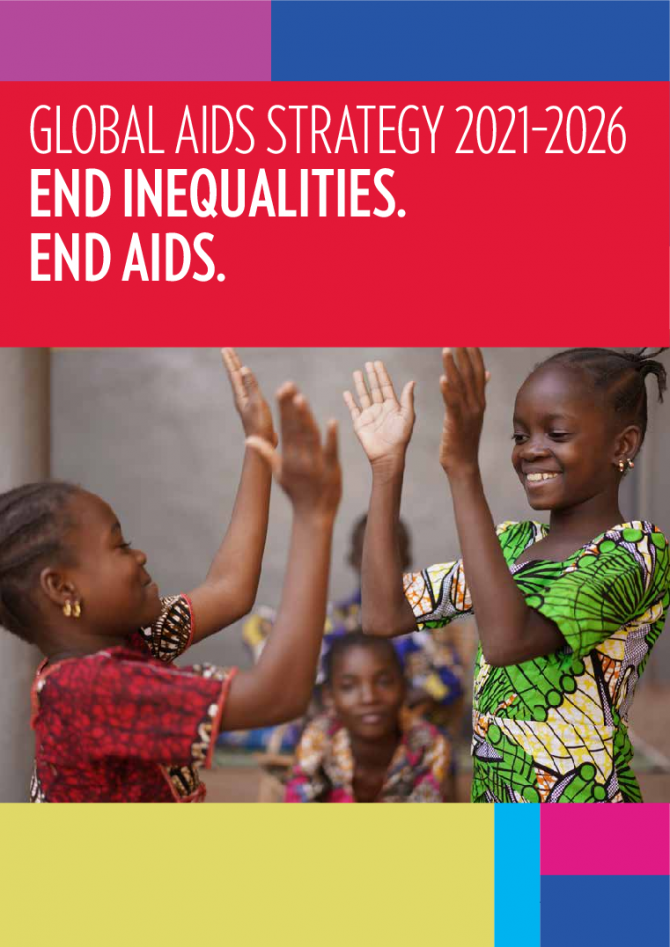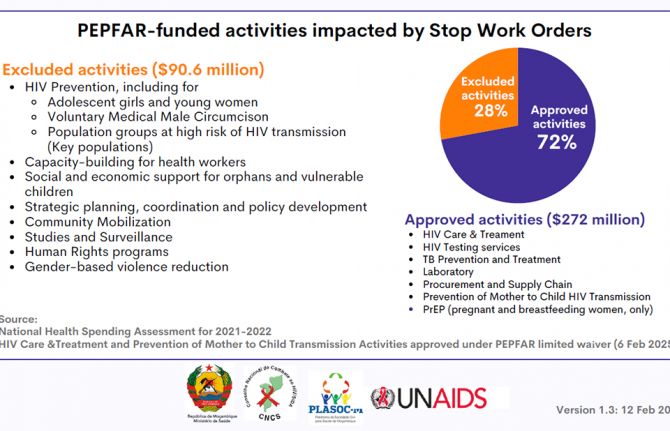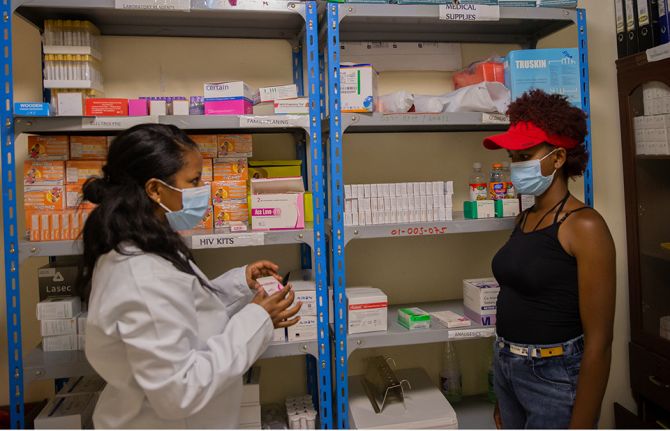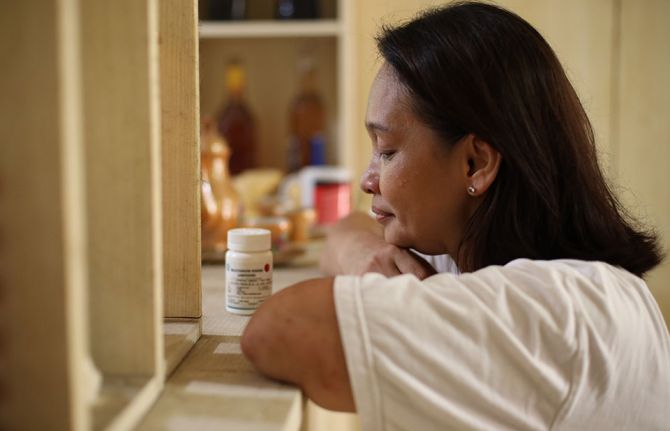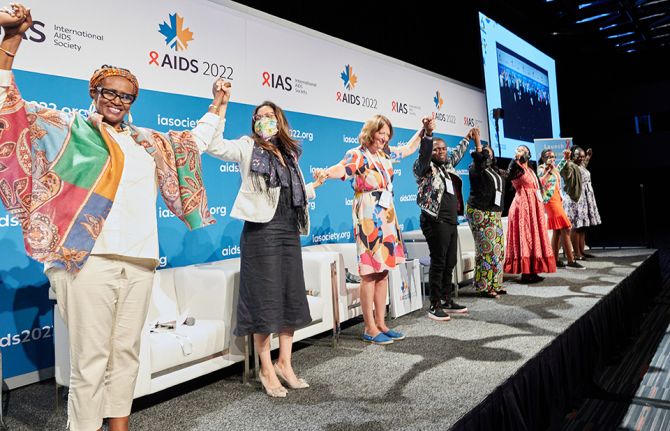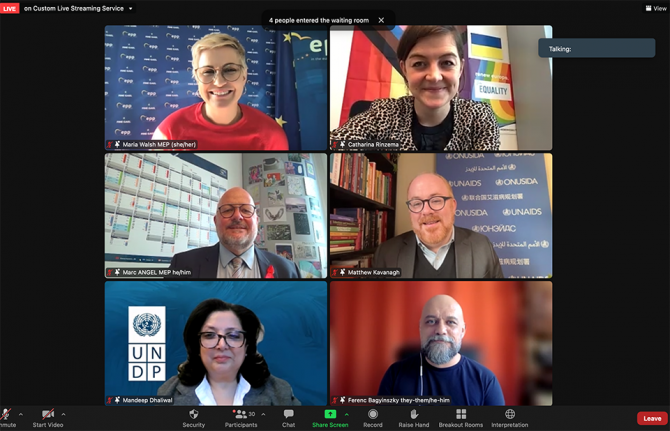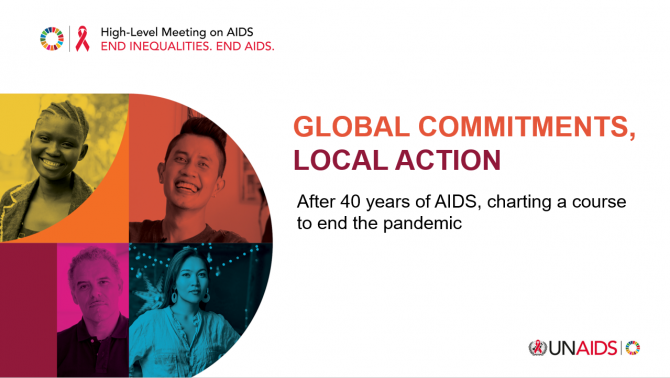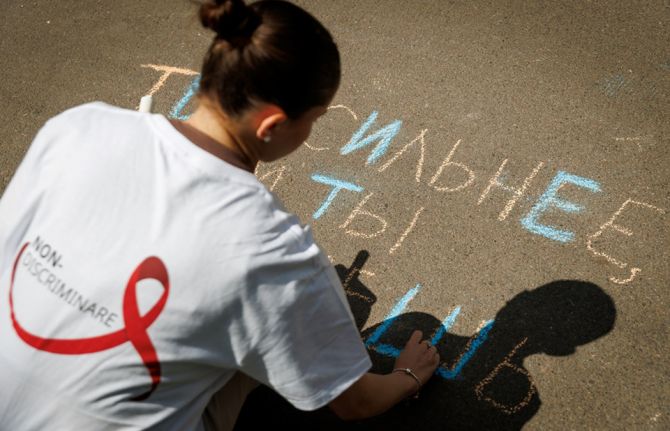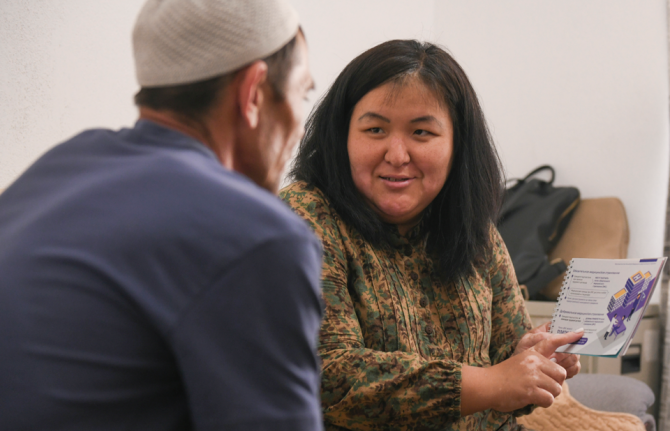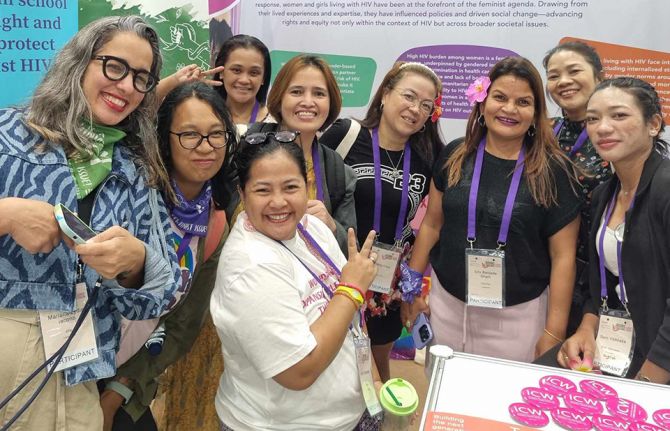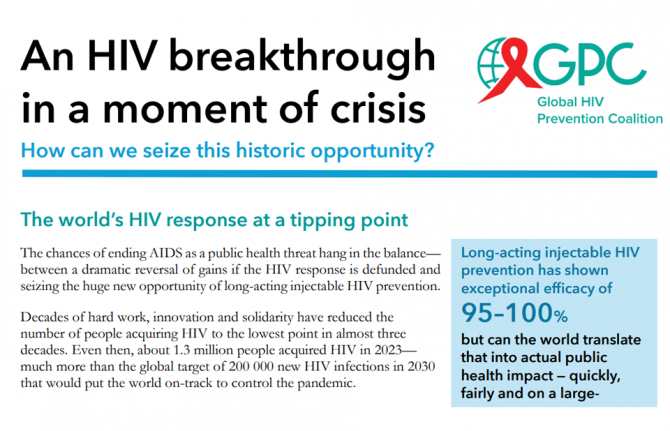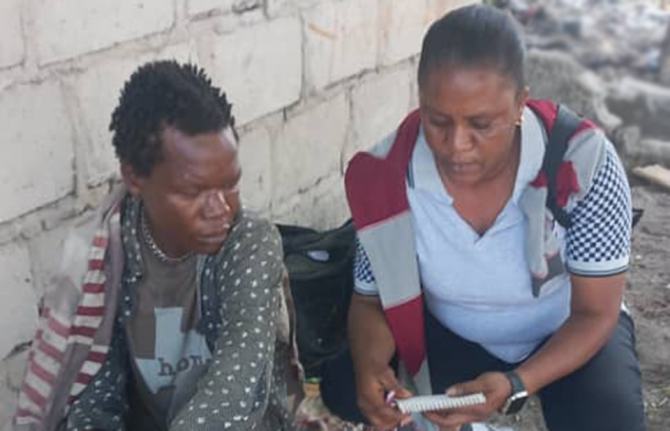Documents
Global AIDS Strategy 2021-2026 — End Inequalities. End AIDS.
25 March 2021
The Global AIDS Strategy 2021–2026 is a bold new approach to use an inequalities lens to close the gaps that are preventing progress towards ending AIDS. The Global AIDS Strategy aims to reduce these inequalities that drive the AIDS epidemic and prioritize people who are not yet accessing life-saving HIV services. The Strategy sets out evidence-based priority actions and bold targets to get every country and every community on-track to end AIDS as a public health threat by 2030. Download Executive summary | Full document This document is also available in Indonesian

Feature Story
Prioritizing human rights to end inequalities and end AIDS
09 June 2021
09 June 2021 09 June 2021Inequalities and human rights barriers, which have been magnified by the COVID-19 pandemic, are preventing progress towards ending AIDS as a global public health threat by 2030. They facilitate the transmission of HIV by increasing vulnerability to HIV and limiting access to health services, particularly for gay men and other men who have sex with men, transgender people, people who use drugs, sex workers, women and girls.
Ending inequalities is both a human rights imperative and a public health necessity. Yet, despite repeated commitments, human rights barriers that drive inequalities, such as stigma, discrimination, violence and punitive laws, continue to undermine the HIV response.
To highlight the critical need for progress on human rights barriers, and to call on all stakeholders to play their part to increase action, UNAIDS convened civil society partners, United Nations Member States, jurists and development organizations on the sidelines of the United Nations High-Level Meeting on AIDS in New York. At the event, From Promises to Action: Scaling Up Efforts against Human Rights Barriers, including HIV-Related Stigma and Discrimination, which took place on 9 June, the panellists emphasized the critical need to generate long-term investment and transformative action on human rights and stigma and discrimination, particularly on discriminatory criminal laws, in order to change structural and social barriers and, ultimately, reduce inequalities.
The panellists exchanged best practices, discussed how human rights-based and gender-transformative approaches could reduce inequalities and issued a call for a rapid scale-up of funding, commitment and action in this area to reach the people most left behind.
The event served as a reminder that 62% of new HIV infections in 2019 were among key populations, who are still criminalized in many countries, and their sexual partners, that due to gender inequality and harmful gender norms, AIDS is still one of the leading causes of death among adolescent girls and young women in sub-Saharan Africa and six out of seven new HIV infections among adolescents (aged 15 to 19 years) in the same region are among girls.
The event also provided hope that action and change is possible. During the event, the Governments of Angola, Costa Rica and the Gambia announced that they are joining the Global Partnership for Action to Eliminate all Forms of HIV-Related Stigma and Discrimination.
At the event, Winnie Byanyima, the UNAIDS Executive Director, called on the international community to rally behind the bold new targets and commitments laid out in the Global AIDS Strategy 2021–2026. She highlighted that the strategy was a crucial development, as it set for the first time specific targets to reduce the societal enablers driving inequality, giving them the same priority and commitment as biomedical interventions.
Having new targets means that there is a need for new tools and guidance, and Ms Byanyima unveiled a new series of human rights fact sheets to support action by all stakeholders on removing human rights barriers, such as criminal laws, stigma and discrimination. The series is available in multiple languages: in addition to English, French, Russian and Spanish (follow the language menu on the top right), it's also available in Portuguese (1, 2, 3, 4, 5, 6, 7).
Quotes
“Failure to make any progress across all societal enablers would undermine prevention, testing, treatment and viral suppression targets, resulting in an additional 1.7 million AIDS-related deaths and 2.5 million additional new HIV infections between 2021and 2030. Failure is therefore not an option.”
“Community leadership is an important component in empowering the community to speak out and raise their issues of concern as to the root causes and drivers of stigma and discrimination. These issues can only be addressed if stakeholders across all levels work together in strong partnership with the community.”
“Reaching this vision, however, requires increased and long-term funding for human rights programmes. We know that breaking down human rights-related barriers to health is key for a healthier, fairer and more resilient world. So let’s seize the opportunity and build back better.”
“If our actions in the AIDS response had been more focused on rights and non-discrimination, gender, socioeconomic integration and universal access, the response to COVID-19 would have been significantly stronger.”
“The HIV pandemic is not over. Our strategy to end it must focus on addressing stigma and eliminating inequalities that are impeding full access to health-care services.”
Our work

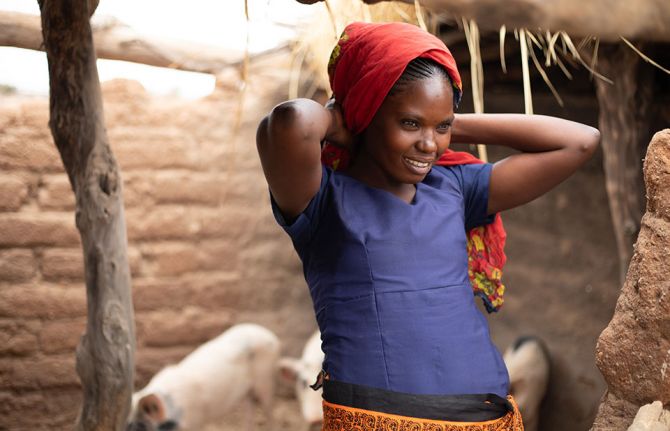
Feature Story
The importance of young people’s sexual and reproductive health and rights to the global HIV response
21 June 2021
21 June 2021 21 June 2021More than a quarter of the world’s population is between the ages of 10 and 24 years—and in some parts of the global South the proportion is two thirds or higher. This is a generation caught between biology and society—between curiosity, questions and concerns about their emerging sexual and reproductive selves and the controls, constraints and conditions imposed by laws, policies and community practices.
On the sidelines of the United Nations High-Level Meeting on AIDS, a group of young activists, government representatives and experts came together in a virtual event on 10 June to discuss the Facts of Life: Youth, Sexuality and HIV.
The meeting, co-hosted by UNAIDS and the International Planned Parenthood Federation (IPPF), brought home the urgency of action. Nearly half of all new HIV infections worldwide occur among young people aged 15 to 24 years, with young women being twice as likely to become infected. Globally, AIDS-related illnesses are the second leading cause of death among young people (aged 10–24 years) and the most common cause of mortality of young people in Africa.
The new Global AIDS Strategy 2021–2026 highlights the urgent need to empower young people to build today’s and lead tomorrow’s HIV response—for themselves and their communities. Nipun Srivastava, a young HIV activist from India, pointed to the challenges ahead. “We have an ambitious target to end AIDS by 2030, but it is not achievable with these regressive policies on sex and sexuality. We lost a lot of people in the 1980s and 1990s because we didn’t talk about sex. We need to stop talking about cows’ and goats’ and bees’ reproduction and speak about sex.”
Efforts to help young people reach their potential in public life need to be mirrored in their private, intimate lives. Alvaro Bermejo, the Director-General of IPPF, emphasized the connection between the physical and emotional well-being of adolescents (including those living with HIV)—and their societies—and access to accurate, age-appropriate sexual and reproductive information and services, allowing them to avoid unwanted pregnancy and unsafe abortion, sexually transmitted infections, including HIV, and all forms of sexual violence and coercion.
And yet, young people’s sexual and reproductive health and rights remain highly controversial. “Case-in-point is the High-Level Meeting on AIDS itself,” said Shereen El Feki, the Director of the UNAIDS Regional Support Team for the Middle East and North Africa. “Some of the most contentious negotiations, and pushback from Member States, on the United Nations Political Declaration on AIDS was on sexual and reproductive health and rights and comprehensive sexuality education.”
The participants heard that the same governments praised for initiatives on young people’s employment or civic engagement often founder when trying to bring the same spirit of youth empowerment to access to youth-friendly sexual and reproductive health and rights services or sexuality education. Amery Browne, the Minister of Foreign and CARICOM Affairs for Trinidad and Tobago, spoke about the delicate act that governments face in balancing conservative forces and youth voices, and urged those working for greater openness to continue their struggle.
Among them is Nadia Abdalla, the Chief Administrative Secretary at the Ministry of ICT, Innovation and Youth in Kenya. A young person herself, she spoke about her country’s efforts to help young people to organize and mobilize for their intimate rights, including their ability to prevent, or live with, HIV. Half-a-world away, sexual and reproductive health and rights activist Ponny White described her work with Advocates for Youth, a nongovernmental organization in the United States of America that lobbies state governments for legal reform to enable young people to access their full sexual and reproductive rights. “A lot of young people are experiencing sexual encounters they don’t understand because someone else is introducing it to them,” she warned, “We want to equip young people with tools and education so they can be autonomous and living a fulfilling life.”
The Internet is one such tool of empowerment. Abir Sarras, the co-founder of Love Matters Arabic, a pioneering social media platform reaching millions of young people across the Middle East and North Africa, pointed to the importance of sex-positive messaging—emphasizing the pleasures, rather than just the problems, associated with sex—as a key means of communicating with young people. But not all young people yet have access to such online resources—Stefania Gianinni, the Director-General for Education at the United Nations Educational, Scientific and Cultural Organization, described the successes and setbacks faced in implementing the United Nations guidance on comprehensive sexuality education in school curricula. “There is no knowledge pill we can give young people,” she said. “But education, hand in hand with access to youth-friendly services, is the most powerful tool for ending AIDS as a public health threat and giving rights to the new generations.”
Documents
2021 HLM report slides
23 June 2021


Feature Story
City leaders unite to regain momentum in the urban HIV response
11 June 2021
11 June 2021 11 June 2021Mayors from four cities, together with a representative of civil society and the core partners of the Fast-Track cities initiative—UNAIDS, the International Association of Providers of AIDS Care (IAPAC), the United Nations Human Settlements Programme (UN-Habitat) and the city of Paris—participated in a virtual side event on urban settings on 10 June, held during the United Nations High-Level Meeting on AIDS.
The participants reflected on the progress made in urban HIV responses and disruptions related to COVID-19, the importance of sustained political leadership and commitment during public health crises and the critical role of communities in strengthening HIV and other health services.
“A Fast-Track city is a city embracing human rights and advocating for more equality and freedom. The freedom to be true to yourself, to live where you want, to live free of prejudice, and with equal chance to stay healthy,” said the Mayor of Paris, Anne Hidalgo, in her opening address.
In her message, Maimunah Mohd Sharif, the Executive Director of UN‐Habitat, highlighted that, “Reducing inequalities is central to both UN-Habitat’s mission broadly and to ending urban HIV epidemics given the unacceptable disparities we see with respect to HIV among sexual and ethnic minorities, including the LGBTQ+ populations, migrants and refugees, and other marginalized populations, such as those in slums and informal settlements.”
Sibongile Tshabalala, the national Chairperson of the Treatment Action Campaign in South Africa, emphasized the importance of community leadership if we want to end AIDS, and called for communities to be at the centre of the HIV response within the context of ending social marginalization and health inequalities.
Attending mayors from Baton Rouge, Johannesburg, Kyiv and Quezon City presented their experiences in exercising public health leadership in HIV responses at the city level and in mitigating the impact of the COVID-19 pandemic. Many cities have made significant progress in accelerating their urban HIV responses since the beginning of the Fast-Track cities initiative on World AIDS Day 2014. In Kyiv, for example, according to national data the percentage of people who know their HIV status and are on antiretroviral therapy rose from less than 50% in 2015 to 83% in 2019, with 95% of those being virally suppressed. In Paris, according to national data the number of new HIV infections dropped by 16% between 2015 and 2018. And in Johannesburg, a targeted testing approach during the COVID-19 pandemic led to an increase in the percentage of people living with HIV knowing their status, from 86% in March 2020 to 91% in 2021, according to national data.
Maria Josefina Belmonte, the Mayor of Quezon City, called on mayors to use the “Power and resources at their disposal towards the common good, including eradicating HIV and addressing issues that others are afraid to address because they are controversial or they may not be acceptable or not be politically sound.” She added that, “It is every person’s right to live freely, humanely and justly in the world they were born in and it is our duty as mayors elected by the people to make that happen for them.”
The moderator of the event, IAPAC President/Chief Executive Officer José M. Zuniga, recognized the progress made by Fast-Track cities, even within the context of the COVID-19 pandemic. “City public health leadership is translating into countless lives saved and enhanced, including as Fast-Track cities grapple with an emerging COVID-19 pandemic and simultaneously work to maintain a continuity of HIV and other essential health services for all of their citizens,” he said.
In many cities, the 90–90–90 targets for 2020 were not achieved, partly because of COVID-19-related disruptions, but also due to persistent inequalities and social exclusion. A prioritization of social enablers is therefore required to regain momentum against HIV across the Fast-Track cities network.
In her closing statement, Winnie Byanyima, the UNAIDS Executive Director, called on cities and municipalities around the world to recommit to accelerated urban HIV responses, to exercise public health leadership to achieve the 2025 targets, to end inequalities and social exclusion and to end AIDS as a public health threat by 2030.

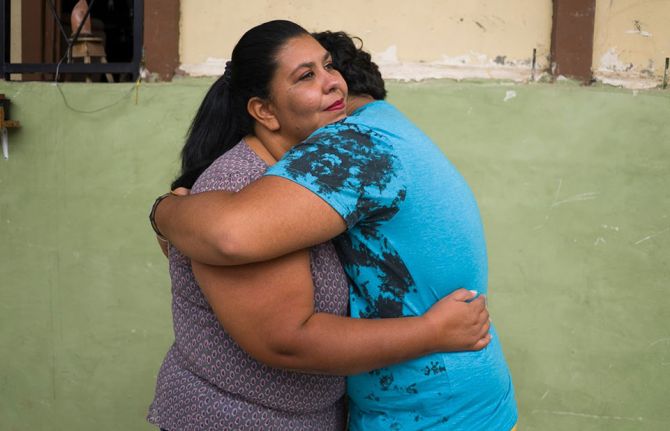
Feature Story
Putting people and communities at the centre of the HIV response
10 June 2021
10 June 2021 10 June 2021Communities living with and affected by HIV, including communities of key populations, are the backbone of the HIV response. They have campaigned for their rights, expanded the evidence base for effective action against HIV, supported the design and implementation of programmes and enhanced the reach and quality of health services. They ensured that the greater involvement of people living with HIV principle became an organizing norm for HIV programmes and that rights-based approaches were widely adopted.
A panel, Putting People and Communities at the Centre of the Response to AIDS, held on the sidelines of the United Nations High-Level Meeting on AIDS on 9 June, saw a high-level discussion on the opportunities and challenges for moving towards the global AIDS targets and realizing the political commitments and policy adaptations needed to support community-led responses as the world moves towards ending AIDS by 2030, and does so in the context of COVID-19.
The panel discussed supporting key population-led, women-led and other community-led responses, new priorities emerging from the community-led response to COVID-19 and fair payment for the community workforce, in particular for women living with HIV and women from key and vulnerable populations.
The panellists heard that more than three decades of experience has clearly shown that communities are at the centre of efforts to end AIDS as a public health threat, but their significant contribution is too often set aside or made more difficult by politicians or public health officials who have little or no knowledge of the lives and experiences of the people they are charged to serve.
They also heard that the response to the COVID-19 pandemic has further underscored the importance of communities in navigating difficult and rapidly changing environments and in reaching affected communities with essential services, such as COVID-19 testing and vaccination and HIV prevention, testing and treatment and other health and social services.
During their discussions, all panellists stressed that communities can deliver when there is an enabling legal environment, operating space for civil society organizations and funding and capacity-building.
Quotes
“The government needs to implement the policies and remove the legal barriers that can enable implementation of the required initiatives. There need to be financing mechanisms and technical support for community-led services, as this is crucial to ensure the quality and sustainability of services, and trusting multisectoral partnerships among stakeholders need to be forged so that there is a united front towards achieving the same goal by putting people at the centre of implementation.”
“Whilst communities are best placed to reach their members, governments have the capacity and resources to support and accelerate progress by ensuring a safe space for civil society through law and policy reform to decriminalize key populations, reduce discrimination and prevent hate crimes, to enable everyone to live peacefully and to enjoy their human rights.”
“Lessons learned from community-led and centred service delivery have strongly shown us that communities have the experience, ability and knowledge on how to best serve their own communities. Communities have a lot to teach us.”
“We cannot end AIDS without investing in harm reduction, community-led responses and the rights of people who use drugs.”
Our work

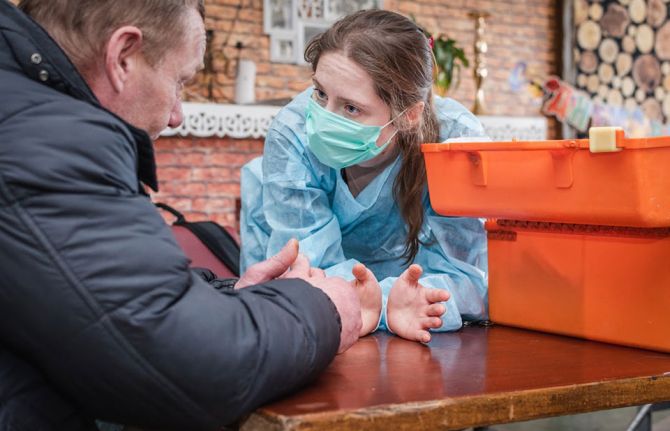
Feature Story
Addressing the impact of the COVID-19 pandemic on the AIDS response
10 June 2021
10 June 2021 10 June 2021A panel that met on the sidelines of the United Nations High-Level Meeting on AIDS, Addressing the Impact of the COVID-19 Pandemic on the AIDS Response and Building Back Better for Pandemic Preparedness, examined how the responses to HIV and COVID-19 can contribute to building multisectoral preparedness and response systems through providing concrete examples of innovations and policy and structural changes introduced in the context of COVID-19.
The panellists, comprising leaders, experts and representatives of community organizations and networks of affected people, addressed how to improve pandemic preparedness and response, and health-care systems more broadly, in the pursuit of the Sustainable Development Goals.
The speakers shared ideas and recommendations to help mobilize political leadership, solidarity and support for ending AIDS by 2030 and for stronger pandemic preparedness for the future. They went on to look at how innovation and technology can address the bottlenecks to achieving Sustainable Development Goal 3 (good health and well-being) through digital health infrastructure and agile, differentiated delivery models. The panellists also addressed the importance of community-led responses in delivering health for all, and reflected on the importance of across- and within-country solidarity in ensuring equitable access to health and socioeconomic support.
Quotes
“HIV setbacks because of COVID-19 would not have happened with more effective protective policies and laws. National sovereignty should not be used against populations in need, but laws should be applied to protect communities.”
“Adaptable institutions like the United States President’s Emergency Plan for AIDS Relief can provide important foundations to protect against future shocks. Countries around the world have been investing in their health systems—looking to future pandemics, we need to focus on prevention as well as preparedness to respond.”
“We need to explore new institutional arrangements to encourage effective multilateralism. All countries need to respond more effectively to best practices, and, for example, learn from the impact of community engagement and leadership in HIV responses.”
“Men who have sex with men, sex workers, transgender people, people who inject drugs and prisoners are particularly vulnerable to HIV and frequently lack adequate access to HIV services. In the context of COVID-19, we must make an extra effort to ensure they access all of the HIV services they need.”
“Pandemic preparedness must be a priority for the African continent. Africa has the largest HIV burden in the world and the pandemic in Africa has disrupted essential services and these disruptions could indirectly kill more than COVID-19 itself.”
Our work

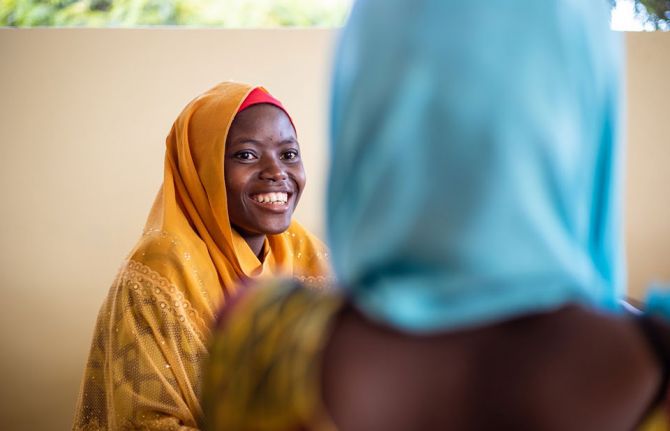
Feature Story
Gender equality and justice critical for ending AIDS
10 June 2021
10 June 2021 10 June 2021On 10 June, representatives of the United Nations, Member States, young women’s movements and civil society laid out strategic pathways for advancing gender justice and women’s rights and agency at a thematic panel, Advancing Gender Equality and Empowering Women and Girls in the AIDS Response, held during the United Nations High-Level Meeting on AIDS.
Despite significant progress in the HIV response, the epidemic continues to take a heavy toll on women and girls. This was an opportunity to reflect on the realities of women and girls in all their diversity in the context of the HIV response and to share forward-looking recommendations on gender equality.
The event came on the heels of a new global pledge by world leaders to reduce the annual number of new HIV infections and AIDS-related deaths, eliminate new HIV infections among children, end paediatric AIDS and eliminate all forms of HIV-related discrimination by 2025. Governments missed the targets made in 2016 to reduce the number of adolescent girls and young women aged 15–24 years becoming newly infected with HIV to 100 000 per year by 2020.
Phumzile Mlambo-Ngcuka, the Executive Director of UN Women, noted the enormous work yet to be done, especially with the challenging convergence of gender-based violence, COVID-19 and HIV, with increased levels of violence against women and girls during lockdowns, spiking by up to 500% in some countries.
Nadine Gasman, President of the National Institute for Women, Mexico, shared best practices from Mexico, where municipal authorities and civil society have worked together to improve access to comprehensive quality HIV services for left-behind populations, such as transgender people, and integrated HIV and sexual and reproductive health services for women living with HIV as well as for gay men and other men who have sex with men and people who inject drugs.
The panel noted that many women, girls and gender-diverse communities at higher risk of and living with HIV are being left behind in HIV testing, treatment and care services. Women and girls continue to face intersecting forms of discrimination, stigma, violence and criminalization.
Particular concern was raised about adolescent girls and young women in sub-Saharan Africa, who remain at intolerably high risk of HIV. In 2020, six in seven new cases of HIV among adolescents between the ages of 15 and 19 years in the region were among girls. The participants stressed the importance of leveraging education, particularly girls’ completion of quality secondary education, as a powerful entry point for accelerating HIV prevention, gender equality, an inclusive environment free of stereotypes, economic empowerment and preventing gender-based violence.
Education Plus, a bold new initiative co-led by the heads of UNAIDS, UN Women, the United Nations Population Fund, the United Nations Educational, Scientific and Cultural Organization and the United Nations Children’s Fund that is calling for high-level political action for the empowerment of young women and girls in sub-Saharan Africa to urgently reduce HIV was hailed as a timely and much needed response. Many emphasized the need to put gender justice at the heart of the HIV response and the sustained meaningful engagement and inclusion of adolescent girls and young women in decision-making at all levels.
The calls to action stressed the importance of scaling up investments in gender-transformative interventions and support for young people’s movements and leadership in the HIV response, legal and policy reforms in parental consent requirements that undermine the right to health of adolescents, the protection of the sexual and reproductive health and rights of all women and adolescent girls and urgently scaling up comprehensive HIV prevention programmes as well as engaging men and boys in transforming harmful gender norms and promoting positive masculinities.
Quotes
“We are closer to ending AIDS than ever before, but HIV is not over, with unacceptably high new HIV infections among adolescent girls and young women in sub-Saharan Africa. Through Generation Equality we will take urgent action on key issues, including women’s bodily autonomy and gender-based violence, working in solidarity through an intergenerational coalition of governments, civil society, feminist and youth organizations, the private sector, philanthropy and international organizations. By working together to address gender inequalities we can drive systemic and lasting change.”
“Now is the time for all of us in the global community to come to grips with the intersecting exclusions and inequalities that perpetuate this crisis. We need radical and rapid transformation of harmful gender norms and practices. But to make that happen, we must give those most affected by HIV a louder voice in our conversations, so they can contribute to the solutions.”
“Criminalization and punitive laws and policies based on sexual activity, sexual orientation and gender identity, drug use and HIV status further expose adolescent girls and young women from key populations to extreme levels of violence, stigma and discrimination. Such laws and policies only drive them further from accessing the HIV prevention and treatment services they need, with little if any recourse to gender and social justice for violations of their rights.”
“We need to enhance our collaborative initiatives between the communities and the schools and realize that the school is a microcosm of what society looks like. The school and the classroom are a reflection and mirror of our communities, and communities mirror what is happening in the classrooms. I implore all of us to make that investment now in adolescent girls, young women and boys as well.”
‘’Any discussion about women’s agency and full participation in decision-making to strengthen HIV prevention and the AIDS response must be anchored in fulfilling a core element of women’s empowerment that cuts across their education, health and economic security: that is, the full respect and protection of their sexual and reproductive health and rights.”
Our work

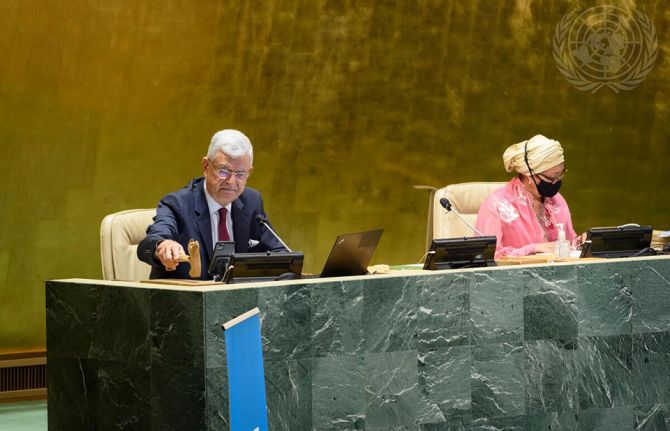
Press Release
United Nations High-Level Meeting on AIDS draws to a close with a strong political declaration and bold new targets to be met by 2025
14 June 2021 14 June 2021NEW YORK/GENEVA, 14 June 2021—After weeks of robust discussions, the 2021 United Nations General Assembly High-Level Meeting on AIDS is drawing to a close with the adoption of a new, ambitious and achievable Political Declaration on HIV and AIDS: Ending Inequalities and Getting on Track to End AIDS by 2030. The declaration is based on evidence, grounded in human rights and will serve as an important road map to advance the global HIV response over the next five years.
“I would like to thank all Member States,” said Winnie Byanyima, Executive Director of UNAIDS. “Over the past two months they have drafted, negotiated and delivered a bold political declaration that will guide global efforts to end a pandemic that has ravaged countries and communities for 40 years.”
Important advances have been achieved in the 2021 political declaration, including new targets to ensure that 95% of people at risk of HIV use combination HIV prevention services, a greater emphasis on community-led provision of services—including a target to ensure that 80% of prevention services for key populations are provided by communities—and a commitment to end inequalities, going far beyond Sustainable Development Goal 10, reduce inequalities.
The High-Level Meeting on AIDS was convened by the President of the General Assembly, with the co-facilitators—the ambassadors of Australia and Namibia—leading negotiations on the political declaration; 193 Member States were represented and the speakers included 14 presidents, five vice-presidents and four prime ministers, with many high-level dignitaries also participating in the thematic panels and 30 supporting events. The events covered issues from how to increase treatment coverage for children to how to scale up harm reduction and empower young people and adolescents.
The five thematic panels were:
- Addressing Inequalities to End AIDS: 10 Years to 2030.
- Putting People and Communities at the Centre of the Response to AIDS.
- Resources and Funding for an Effective AIDS Response.
- Advancing Gender Equality and Empowering Women and Girls in the AIDS Response.
- Addressing the Impact of the COVID-19 Pandemic on the AIDS Response and Building Back Better for Pandemic Preparedness.
The High-Level Meeting on AIDS featured the participation of people living with HIV, senior United Nations officials, representatives of international organizations, the private sector, civil society and academia and other stakeholders, who discussed practical ways of translating the new political declaration into action and results.
Eminent person and long-time AIDS activist Sir Elton John, founder of the Elton John AIDS Foundation, made a strong call to action by video message, saying, “With your leadership, we can defeat AIDS and COVID-19 and be better prepared for other pandemics that will follow. You can and will make the difference. And you have an army of supporters standing behind you, including the 38 million people living with HIV around the world. Together, we can bring an end to fear and inequality—and, by the end of this decade, end the AIDS pandemic, once and for all! The world is watching and we don’t have a moment to waste.”
UNAIDS
The Joint United Nations Programme on HIV/AIDS (UNAIDS) leads and inspires the world to achieve its shared vision of zero new HIV infections, zero discrimination and zero AIDS-related deaths. UNAIDS unites the efforts of 11 UN organizations—UNHCR, UNICEF, WFP, UNDP, UNFPA, UNODC, UN Women, ILO, UNESCO, WHO and the World Bank—and works closely with global and national partners towards ending the AIDS epidemic by 2030 as part of the Sustainable Development Goals. Learn more at unaids.org and connect with us on Facebook, Twitter, Instagram and YouTube.
"Compassion, courage and equality," says Sir Elton John
"Let us learn the lessons of the past and not repeat them," says Sir Elton John

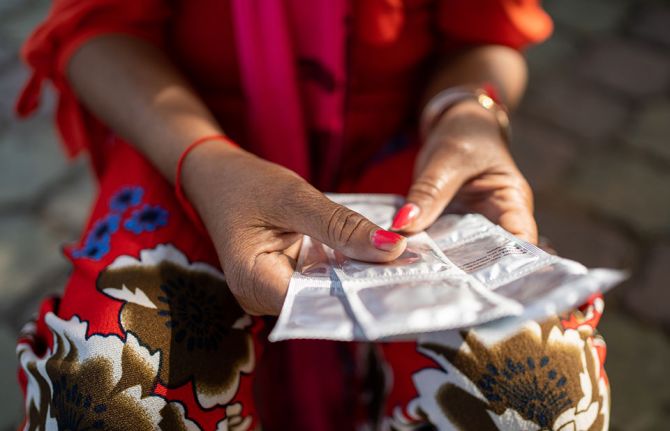
Feature Story
Global HIV Prevention Coalition reinforces the need for leadership and decisive action
14 June 2021
14 June 2021 14 June 2021Forty years into the HIV epidemic, despite there being a range of HIV prevention interventions, none of the recommended HIV prevention packages have come close to being delivered to half of the people who need them.
But there have been successes in reducing new HIV infections among the most vulnerable populations where rights-based multisectoral action has been taken, where data-driven solutions have been promoted and resourced and where the voices and contributions of the most affected communities have been leveraged.
On the sidelines of the United Nations High-Level Meeting on AIDS, a side event, No Prevention, No End: The Importance of Leadership for HIV Prevention, saw the participants—political, technical and community leaders and donors—address the gaps in HIV prevention, discuss the most effective ways to invest in and develop HIV prevention programmes and share experiences of successful country-level action.
Nguyễn Thanh Long, the Minister of Health of Viet Nam, shared an example. A threefold decrease in HIV prevalence among people who inject drugs in Viet Nam was principally a result, he said, of considering drug addiction as a medical condition requiring treatment and not as a crime. Introducing this perception into legal policy documents, including the Government Decree and the Law on HIV/AIDS Control, enabled the initiation and scale-up of comprehensive harm reduction programmes for people who inject drugs.
Adolescent girls and young women account for one in four new HIV infections in sub-Saharan Africa, yet dedicated HIV prevention programmes are present in only a third of high HIV burden districts. According to Pascalle Grotenhuis, the Dutch Ambassador for Women’s Rights and Gender Equality, who also drew on her experience as the Ambassador of the Netherlands to Mozambique, the time is ripe for pragmatism and common sense in strengthening sexual and reproductive health services for young people, with sexual health at the core, offering dual protection against sexually transmitted infections, including HIV, and unwanted pregnancy. Above all, sexuality education for young people must be recognized as a life-saving intervention, she said.
Quotes
“Forty years into the epidemic, we can’t lean on the excuse that prevention is complicated, it is not. We all have to raise our voices and speak truth.”
“The most remarkable options developed by science will not end the epidemic. Our leadership, our policies and programmes that are grounded in the communities we seek to serve provide choices to people.”
“The law shows the standard which the public are expected to observe. Above all, the law says that discrimination against LGBTQ communities is wrong. It recognizes that prejudice kills whereas equality saves lives and makes everyone safer. That is the case for decriminalization.”
“HIV prevention and sexual and reproductive health services are critical to the lives of every young woman and girl. These services should be free, they should be fully integrated, should be delivered at scale and tailored to meet the holistic needs of young women. New commodities and prevention technologies should be rolled out and made available to every young woman. Having these tools will mean nothing if they don’t get into the hands of young women.”
“We are together in this quest for zero new HIV infections and our leadership that can turn this epidemic. Our commitment for HIV prevention must be translated into funding at an adequate scale for impact, and we must invest in national stewardship and coordination support so that HIV prevention programmes do not fragment into the piecemeal projects that we sometimes see in countries.”

